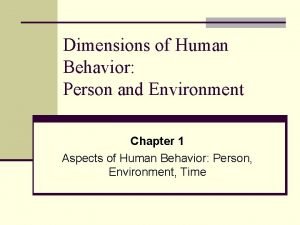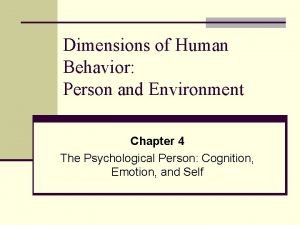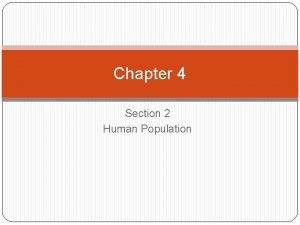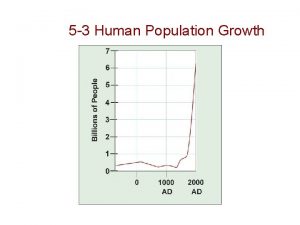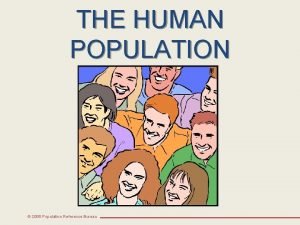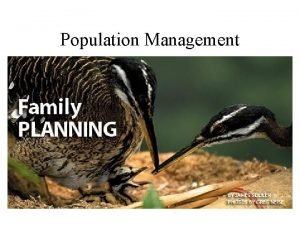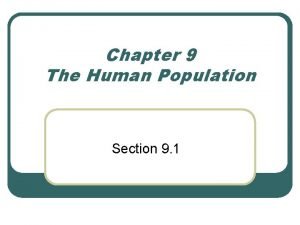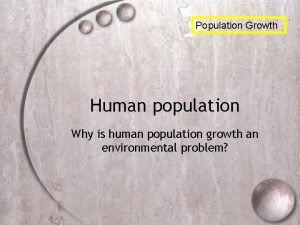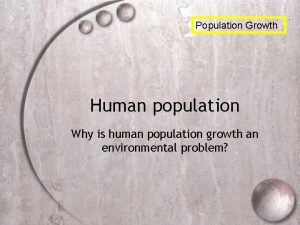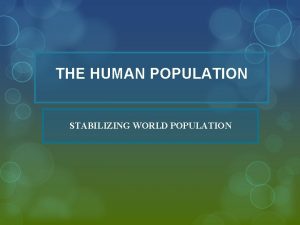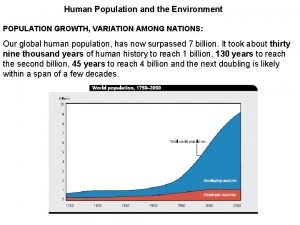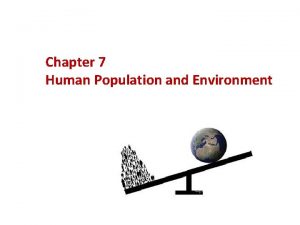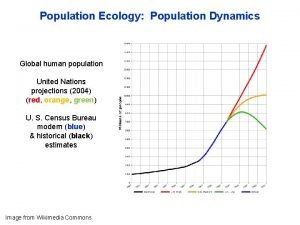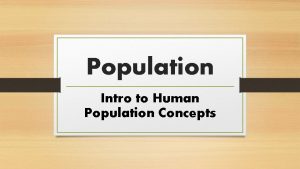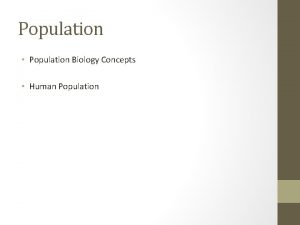Lecture 3 Human Population And Environment HRh Human




















- Slides: 20

Lecture 3 Human Population And Environment HRh

Human Population & Environment n Environmental degradation, hunger, persistent poverty, economic stagnation, urban deterioration, and health issues will continue to challenge us as our numbers increase during the 21 st century n Demands of increasing population coupled with desire for a higher standard of living result worldwide pollution on a massive scale

n Case Study: Bangladesh Ø With a growth rate of 1. 48 total population is over 160 million (March, 2009) Annual increase is over 2 million Recently more than 100, 000 died because of storm & tidal surge This tragedy is made even more tragic by the fact that this number were replaced in 2 wks One of the poorest nations & this poverty affects human survival Calories available person is only 85% of the required for good health Less than half of the population has access to safe drinking water & less than a fifth has access to adequate sanitation With inadequate resource & rapid growth rate, Bangladesh struggles to maintain even its existing poor standard of living Low-lying coastal areas are fundamentally uninhabitable at high densities for extended periods Are inhabited now only because of huge numbers of people in the country For Bangladesh it is difficult to talk about solving environmental problems, conserving biological diversity Growth of human population erases any advances Already the land is overused for grazing & crop production Ø Ø Ø

Human Population Growth v Ø Ø Ø The underlying issue of the environment, because most current environmental damage results from the very large number of people on earth As of April 2010, the earth's population is estimated to be about 7 billion Since births outnumber deaths, the world's population is expected to reach about 9 billion by the year 2040, and 10 -14 billion by 2100 We cannot solve environmental problems unless we limit the total number to the number that the environment can sustain

Human Population Growth Countries ranking in the top 40 both in terms of total population (more than 29 million people) and population density (more than 310 people per square kilometer): Country India Bangladesh country Japan Philippines South Korea Population 1, 160, 139, 960 155, 688, 660 Density Notes 352. 9 Second largest country 1, 055. 0 Largest fast growing 127, 170, 110 93, 843, 460 49, 354, 980 336. 5 312. 8 493. 4 Declining in population Fast growing country Steady in population The ten countries which will contribute most to world population growth over the next 30 years are India, China, Pakistan, Nigeria, Ethiopia, Indonesia, United States of America, Bangladesh, Zaire, and Iran - in that order!

Environmental impact of population Can be shown by EI = P × A × T where, EI the environmental impact of a population of a given area P the number of population of a given area A the affluence/person; a measure of consumption T the environmental effects of the technologies to obtain & consume resources n This model demonstrates that although increasing motor vehicle efficiency and developing cleaner technologies will reduce pollution and environmental degradation, a larger reduction will result if population and per-capita consumption are also controlled

Human Population & Environment n Ø Ø Factors affecting population growth Populations grow or decrease through the interplay of three factors: births, deaths, & migration Population change = (Births + Immigration) – (Deaths + Emigration) Annual rate of Birth rate – Death rate natural change(%) = -------------- x 100 1, 000 persons

Human Population & Environment n n n n n Growth depends on Social, political, economic, ethical factors Social Factors The major social factors that determine family size are the status and desires of women As women become better educated and obtain higher paying jobs, they become financially independent and can afford to marry later, use birth control and consequently have fewer children What is most important is the desire of women to limit the size of their families Political Factors Two other factors that influence the population growth rate of a country are government policies on population growth and immigration Birth rates are currently so low in several countries that these countries will likely have a shortage of those of working age in the near future One way to solve this problem is to encourage immigration from other parts of the world

Terms related to Human Population Demography – The scientific study of human populations, their characteristics, how these characteristics affect growth, and the consequences of that growth is known as demography n Population dynamics —the study of changes in population sizes and the causes of these changes n Population —Group of individuals of the same species living in the same area capable of interbreeding and sharing genetic information n Species: Group of organisms that resemble one another in appearance, behavior, chemical makeup and processes, and genetic structure, capable of interbreeding and producing fertile offspring A species is made up of populations n Doubling Time: Time required for a population to double in size n How rapidly a population changes depends on the growth rate — difference between birth rate and the death rate n

Ø Ø Exponential Growth It means that a population increases by a constant percentage in each unit of time It occurs when resources are not limiting Exponential growth starts out slowly & then proceeds faster & faster as the population increases; yields a J-shaped exponential growth curve However, no population can sustain exponential rate of growth; eventually population will run out of food and space Logistic Growth n Ø Ø Ø It involves exponential growth followed by a steady decrease with time as the population encounters environmental resistance and approaches the carrying capacity of its environment & levels off With this type of growth population typically fluctuates slightly above & below the carrying capacity; yields a S-shaped curve Although logistic growth curve has been used frequently to project maximum population size it involves assumptions that are unrealistic for humans and other mammals Especially unrealistic if death rates continue to decrease owing to improvements in health, medicine, and food supplies

Growth of Population—Different Societies & their Impacts on Environment Four major periods 1 Hunters and gatherers: From evolution to beginning of agriculture; less than a few million; growth rate 0. 00011%/yr; 1 person /130 -260 km 2 n Small population sizes, low resource use, migration, and lack of technology, less impact on environment 2 Early, Preindustrial Agriculture: Ø Rise of agriculture allowed a much greater density of people; 1 or 2 people/km 2; growth rate of 0. 03%/yr Ø Environmental degradation from soil erosion, and livestock overgrazing was a factor in the downfall of great civilization 3. The Machine Age: Growth rate actually increased during the 1 st part of the 20 th century, peaking during 1965 -70 at 2. 1% owing to improvements in health, medicine, & food production Environmental impact was quite significant 4. The Modern Era Ø About 7 billion as of April, 2010 Ø Growth rate slowed in wealthy, industrialized nations but continues to increase rapidly in poorer, less developed nations n Use of technology caused significant damage to the environment Ø Increased Air pollution, Water pollution, Waste production, Soil degradation, Groundwater depletion, Habitat destruction & degradation, Biodiversity depletion

Age structure n Ø Ø v Ø Ø Ø Proportion of population in each age class, a component of demography, affects current and future birth rates, death rates, and growth rates; our impact on the environment; and social and economic status Three age categories: prereproductive (ages 0 -14 yrs), reproductive (ages 15 -45), & postreproductive (ages 45 & up) Future changes in population can be predicted from the diagram Structure with a very high growth rate is shaped like a pyramid Developing countries with 37% of the populations below age 15 have this type structure Because when all these children mature, they will become the parents of the next generation, & this group of parents will be larger than the previous group Most of the increase in population since 1950 has taken place in developing countries as a result of this younger age structure and high fertility rates of their population

Age structure Diagram v v v In countries with stable population, the numbers of people at prereproductive and reproductive ages are approximately same Also, larger proportion of population is older, i. e. postreproductive In countries where population is shrinking, people at prereproductive is smaller than either reproductive or postreproductive group (Russia)

Demographic Transition n n n n The demographic transition is a FOUR-stage pattern of change in birth rates and death rates as a country is transformed from undeveloped to develop It leads to a decline in population growth Initially, countries have a stable population with a high birthrate and a high death rate As countries become industrialized, the birthrates begin to drop because people desire smaller families and use contraceptives Eventually, birthrates and death rates again become balanced, with low birthrates and low death rates It suggests that if a country can become industrialized, then social, political, and economic processes will naturally cause its population to stabilize As a result of a common desire among parents for large families, as in the case of Bangladesh, the growth rate is so high that it outpaces increases in economic development The key point here is that the demographic transition will only take place if parents come to believe that a small family size is to their benefit


Limiting Factors Population that exceeds the carrying capacity (maximum population size that can be sustained indefinitely by the environment) will change the environment in a way that will decrease future population size v Eventually the population will run out food and space v Limiting factors include: v local loss of current crops, energy shortages that affect food production & disruption in the distribution, abrupt change in weather, climatic changes, decline in groundwater supplies, desertification, soil erosion, major world catastrophes (outbreak of disease), acid rain, etc

Total Fertility Rate and Replacement-Level Fertility n n Ø Ø n n An important factor that can delay changes in population growth is the average number of children expected to be born to a woman during her lifetime, known as the total fertility rate, or TFR A population that maintained a TFR of 3. 8 over a long time would increase rapidly, whereas a population that had a TFR of 2. 0 over a long time would decline Replacement-level fertility (RLF) is the TFR required for a population to remain constant A total fertility rate of 2. 1, that is, replacement-level fertility will not necessarily immediately result in a stable population with zero growth for several reasons A comparison of nations suggests that the TFR declines as income increases Bangladesh, which has an average income person of a few hundred dollars per year, has a high fertility rate—approximately 2. 83 (In Sri Lanka it is 1. 88) children born to each woman

Future Population Trends Ø Ø Ø Ø Mortality will fall everywhere and level off Fertility will reach replacement levels everywhere between 2005 -2060 Equilibrium world population of 10. 1 to 12. 5 billion Developing countries would increase from 4. 5 billion to 9. 6 billion Developed countries (from 1. 2 billion today to 1. 9 billion Developing countries contribute 95% of the increase Bangladesh would reach 257 million

How to slow population growth v Ø Ø v v v q Delay the age of first childbearing by woman: Social pressures that lead to deferred marriage Stop early marriage: In Bangladesh, average for marriage is 16 whereas in Sri Lanka it is 25 Increase in marriage could account for 40 -50% drop in fertility required to achieve zero population growth Change in attitude, knowledge of means to control birth, and the ability to afford these means Increase in education and job opportunities for young women and standard of living Women empowerment The best way is a combination of family planning, reducing poverty, and elevating the status of women

END OF SLIDES
 Hrh 2030
Hrh 2030 01:640:244 lecture notes - lecture 15: plat, idah, farad
01:640:244 lecture notes - lecture 15: plat, idah, farad Population ecology section 1 population dynamics answer key
Population ecology section 1 population dynamics answer key Section 1 population dynamics
Section 1 population dynamics Population ecology section 1 population dynamics
Population ecology section 1 population dynamics Chapter 4 section 1 population dynamics answer key
Chapter 4 section 1 population dynamics answer key Financial environment of business
Financial environment of business Biological dimension of human behavior
Biological dimension of human behavior Dimensions of human behavior: person and environment
Dimensions of human behavior: person and environment Human resource management lecture chapter 1
Human resource management lecture chapter 1 Human resources management chapter 1
Human resources management chapter 1 Human resource management lecture chapter 1
Human resource management lecture chapter 1 Chapter 4 section 2 human population answer key
Chapter 4 section 2 human population answer key Chapter 4 section 1 population dynamics answer key
Chapter 4 section 1 population dynamics answer key Whats a density dependent limiting factor
Whats a density dependent limiting factor 5-3 human population growth
5-3 human population growth Human population
Human population Generator in human design
Generator in human design Baby bust definition ap human geography
Baby bust definition ap human geography What is population management
What is population management Chapter 9 the human population section 1
Chapter 9 the human population section 1







